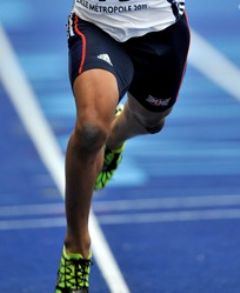After a 2 week absence, I jumped back on my bike & returned to Lee Valley Athletics Centre today. As usual, nothing dramatic has changed whilst I've been away but it was good to catch up on everyone's news.
One of the athletes that has warranted discussion is a young sprinter with a history of anterior knee pain, first experienced in the summer...interestingly the first MRI scan came back with normal findings reported, however it wasn't until the scans were examined a little more closely that we realised the NHS had scanned the wrong knee!!! In this particular group of athletes, one condition that has to be considered is Sinding Larsen Johansson syndrome, which is specific to the developing musculoskeletal system.
If you have yet to observe a case, here is my brief overview of Sinding Larsen Johansson Syndrome:
Description
Sinding Larsen Johansson syndrome (distal patellar apophysitis) is inflammation
of the growth plate (apophysis) at the very bottom of the kneecap (inferior
pole of the patella). This is the site of origin of the patellar tendon.
In children,
the bones grow from the areas called growth plates, which are made up of cartilage
cells, which are softer & less resistant to injury that mature bone.
Sinding-Larsen-Johansson
syndrome occurs when there is increased tension & pressure on the growth
centre. This usually occurs as a result
of repeated stress or vigorous exercise (overuse), although the risk of
irritating the growth plate can be increased by having tight quadriceps, which
can often occur at the time of a growth spurt.
This is a
temporary condition, seen most often in children between the ages of 10 &
15, whilst rarely seen after the age of16. It is the childrenís equivalent of patella
tendinitis (jumperís knee).
Common Signs and Symptoms
- Slightly swollen,
warm & tender bump below the kneecap
- Pain with activity,
especially when straightening the leg against force (such as with stair
climbing, jumping, deep knee bends, or weightlifting) or following an
extended period of vigorous exercise in an adolescent
- In more severe
cases, pain during less vigorous activity
Assessment & Diagnosis
After conducting routine subjective & objective examinations (history
& knee joint specific plus full functional system assessment), a diagnosis
may be confirmed by x-ray, showing irregular boney edges or fragments at the
tip of the inferior pole of the patella.
Treatment Considerations
Initial treatment consists of:
-
Ice to
relieve pain (20 minutes every 2 hours after exercise)
-
Stretching exercises
targeting the hip flexors (quadriceps & psoas muscles)
-
Strengthening
exercises (quadriceps) aiming to improve the stiffness of the patella tendon,
thus improving the loading capabilities of the tendon. If through range loading is painful
initially, heavy isometric holds can be a good starting point. Once this can be tolerated, heavy eccentric
squats should be introduced through a comfortable range.
-
Strengthening
exercises (gluteus medius, posterior chain, lower abdominals) aiming to improve
hip & pelvic control.
-
In acute
cases, activity should be pain limited & in certain instances modified. Specifically, kneeling, jumping, squatting,
stair climbing & running on the affected knee should be avoided.
-
A patellar
band (brace between the kneecap & tibial tubercle on top of the patellar
tendon) may help relieve symptoms.
Return to Sport
Return to activity
should be conducted using a graduated loading programme, with pain being a
limiting marker. If the pain is ignored,
chronic inflammation may occur, causing increased growth plate swelling &
chronic pain may become an issue.
A
criterion-based progression should be adopted as opposed to a time-line
progression. In addition to pain on
palpation & swelling parameters, gauge progress using objective markers
such as pain-free range of movement, resisted quadriceps contraction,
walking/jogging/sprinting pain free over a specific time or distance, cutting
over a certain angle pain free, completing a certain number of figure-of-8
runs, ability to perform single/double leg jumps pain free.
Warming up & cooling down either side of activity should be encouraged, with light jogging or cycling increasing the tendon loading through a moderate range initially, whilst increasing the blood flow to the muscles & increasing the pliability of the myofascial system.
Multi-chain
active range of movement & fascial exercise cycles should be included in
addition to core activation activities, followed by quadriceps stretching &
glutes/hamstring activation exercises.
If you have seen many cases of Sinding Larsen Johansson Syndrome, please feel free to contribute to the blog in the comments box below.

